|
|
|
A "Petit Point" about Maintenon's castel.
 The history of the Maintenon's castle ascends to the Middle-Age,
as testifies its squared tour of the XIIth century. The history of the Maintenon's castle ascends to the Middle-Age,
as testifies its squared tour of the XIIth century.
This castle was offered by Louis XIVth to Madam de Maintenon in 1674 which was then governess the illegitimate childs of Madame de Montespan.
This "favourite" lady found refuge here several times and delivered there Mademoiselle of Blois and the Count of Toulouse in 1677 and 1678. by Louis XIVth to Madam de Maintenon in 1674 which was then governess the illegitimate childs of Madame de Montespan.
This "favourite" lady found refuge here several times and delivered there Mademoiselle of Blois and the Count of Toulouse in 1677 and 1678.
The castle situates between Chartres, Rambouillet and Ablis.
Tell me more
|
|
Out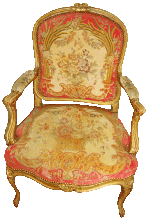
 the relative circle and until Madame de MAINTENON's time, nobody had worried about teatching needlepoint tapestry no more yet the basketweave* stitch.
the relative circle and until Madame de MAINTENON's time, nobody had worried about teatching needlepoint tapestry no more yet the basketweave* stitch.
That stitch has insurpassable qualities as robustness and perfect finishing aspect. It is why this Saint Cyr Petit Point was often used for needlepoint seat covering.
It is of her desire to give a fine education to the noble but orphan girls that in her second installation of Louis the Holy education's house to
Saint-Cyr
village, will be teatched the first "Petit Point lesson". Since, this Petit Point kepts registered in its name the place of its birth to "Saint Cyr" (a today small town close from south Paris).
Tell me more
* Small stitch used for needlepoint: a diagonal stitch, synonym, but not same, of tent stitch; often says Petit Point, pronunciation: "petee poynt"
|
|
The Petit Point called Saint Cyr stitch (Basketweave)
Hitherto one used different
 stitch such:
"done with the big stitch on canvas", or
"done with cross stitch of gold, silver and silk threads..."
No yet was used the Basketweave.
The inventory of the crown jewels, drawn up to the castle of Vincennes in 1418 announces "a small stitched purse".
In 1480, the widow of king Rene ask to carry out to Jean Guillebert, her carpenter, a tapestry standing frame; too in 1483, in the inventory of Charlotte of Savoy, widow of Louis XI,
a tapestry frame is mentioned. Catherine de Médicis, to the statement of Brantôme, "
stitch such:
"done with the big stitch on canvas", or
"done with cross stitch of gold, silver and silk threads..."
No yet was used the Basketweave.
The inventory of the crown jewels, drawn up to the castle of Vincennes in 1418 announces "a small stitched purse".
In 1480, the widow of king Rene ask to carry out to Jean Guillebert, her carpenter, a tapestry standing frame; too in 1483, in the inventory of Charlotte of Savoy, widow of Louis XI,
a tapestry frame is mentioned. Catherine de Médicis, to the statement of Brantôme, "
 took lot of time, after-diner with her works of silk and wool where she was as well perfect as it was possible".
(Let us note that it is in her honor that DMC® created the prestigious range of tapestry wools of her name.) Madam de Maintenon integrated this knowledge of making and all these tapestry stitches in her lessons. But the most beautiful of all these stitches, the most solid, the finest was taught at the end of studies.
Since then in France the needlepoint enthousiasts calls it the saint Cyr stitch.
Tell me more
took lot of time, after-diner with her works of silk and wool where she was as well perfect as it was possible".
(Let us note that it is in her honor that DMC® created the prestigious range of tapestry wools of her name.) Madam de Maintenon integrated this knowledge of making and all these tapestry stitches in her lessons. But the most beautiful of all these stitches, the most solid, the finest was taught at the end of studies.
Since then in France the needlepoint enthousiasts calls it the saint Cyr stitch.
Tell me more
|
|
Francoise d' Aubigné, widow of the Scarron poet and Marquise de Maintenon, widow of the Scarron poet and Marquise de Maintenon,
 became owner of the field in 1674. She increased and
embellished the castle, before becoming in 1684, the secret wife of Louis XIVth. Racine, the great poet, wrote in Maintenon the tragedies "Esther"
and "Athalie". Le Nôtre, the gardener who invented the "Jardin à la Française" and sets up those of Versailles, drew the park and the flower bed, and dug the large
channel which flow under the aquaduc built by Vauban and La Hire. This unfinished building was to bring water from the close Eure river toward Versailles. The work started into 1684 employed thirty thousand people and was abandoned in 1710. became owner of the field in 1674. She increased and
embellished the castle, before becoming in 1684, the secret wife of Louis XIVth. Racine, the great poet, wrote in Maintenon the tragedies "Esther"
and "Athalie". Le Nôtre, the gardener who invented the "Jardin à la Française" and sets up those of Versailles, drew the park and the flower bed, and dug the large
channel which flow under the aquaduc built by Vauban and La Hire. This unfinished building was to bring water from the close Eure river toward Versailles. The work started into 1684 employed thirty thousand people and was abandoned in 1710.
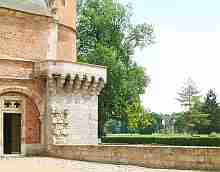
In a letter addressed on February 5, 1675 to Madam de Coulanges, Madam de Maintenon wrote: "I was two days at Maintenon which appeared one moment to me; my heart is attached there. It is a beautiful house aenough. A little too large for the style of living that I intend there. It has very beautiful bowling green, wood..."
With the return of a voyage to Maintenon, the King, while, speaking to her, named her in front of everyone. "Madam de Maintenon". "It is true," she wrote February 6, 1675 to Gobelin abbot, "that the King named me Madam de Maintenon, and that I had the imbecility to blush about it..., I will not however have Tell me more great kindness for him than only bear the name of a ground he gave me".
Start |
Tell me more & end
|
|
 It is on November 24, 1635 which was born Francoise d' Aubigné in the caretaker's lodge of the prison of Niort. His father, Constant of Aubigné lord of Aubigny and Surimeau was the son of the famous poet calvinist Agrippa d'Aubigné. Imprisoned to have tested himself with the forging money; his wife Jeanne de Cardilhac, remained at his sides, delivred the prety girl who one day will take place of the morganatic wife of the Sun king Louis the XIVth.
It is on November 24, 1635 which was born Francoise d' Aubigné in the caretaker's lodge of the prison of Niort. His father, Constant of Aubigné lord of Aubigny and Surimeau was the son of the famous poet calvinist Agrippa d'Aubigné. Imprisoned to have tested himself with the forging money; his wife Jeanne de Cardilhac, remained at his sides, delivred the prety girl who one day will take place of the morganatic wife of the Sun king Louis the XIVth.
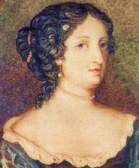 Abducted from her parents, Madam de Neuillant who had took her in decided to marry Francoise. The choice was made on a certain Paul Scarron. This man born in 1610 of a Parisian member of Parliament and a daughter of magistrate, was a picturesque poet and of great fame. Alas, they was its only qualities because it was not only too old for the young girl (25 years oldest) but he got also a illness of a terrible form of deforming rheumatism which attacks the vertebrae. In spite of its handicap, Scarron was very appreciated and held "meeting room" at home. One found there famous people such great writers like Benserade or Marigny, such too lords as Gabriel de Rochechouart Duc of Mortemar, prince of Tonnay-Charente, first gentleman of the room of the king, the marquis de Villarceaux, the wolf hunter chief intendant (Louvetier) of Louis XIVth; one found there also great ladies like the marchioness de Sévigné, Madam de La Fayette or Ninon de Lanclos. The living room was always full of people and many men were attracted by the beautiful eyes of the housewife, in particular the Marshals of Aumont as well as Sir Albret. The state of Scarron worsened about 1660. He gave its last sigh the same year. Leaving a young widow of 25 years old, involved in debt and not being able to regulate all the credits, Mrs Scarron withdrew herself to the convent of the Hospital's hostess. Abducted from her parents, Madam de Neuillant who had took her in decided to marry Francoise. The choice was made on a certain Paul Scarron. This man born in 1610 of a Parisian member of Parliament and a daughter of magistrate, was a picturesque poet and of great fame. Alas, they was its only qualities because it was not only too old for the young girl (25 years oldest) but he got also a illness of a terrible form of deforming rheumatism which attacks the vertebrae. In spite of its handicap, Scarron was very appreciated and held "meeting room" at home. One found there famous people such great writers like Benserade or Marigny, such too lords as Gabriel de Rochechouart Duc of Mortemar, prince of Tonnay-Charente, first gentleman of the room of the king, the marquis de Villarceaux, the wolf hunter chief intendant (Louvetier) of Louis XIVth; one found there also great ladies like the marchioness de Sévigné, Madam de La Fayette or Ninon de Lanclos. The living room was always full of people and many men were attracted by the beautiful eyes of the housewife, in particular the Marshals of Aumont as well as Sir Albret. The state of Scarron worsened about 1660. He gave its last sigh the same year. Leaving a young widow of 25 years old, involved in debt and not being able to regulate all the credits, Mrs Scarron withdrew herself to the convent of the Hospital's hostess.
 By the grace of her friends and admirors she obtained a pension of the queen mother Anne of Austria. What enabled her to leave the convent and to settle in a housing located in the "Marais" area in Paris. It is at the time of one cocktail party at the Albret home that she met for the first time Madam de Montespan with who she decided to bind her destiny. Its true relation with the king begins in 1675, Tell me moreover Louis XIVth writing in his journal "a few days ago, a gentleman of gray clothed, perhaps a prince wandering incognito undertook during the night a nymph mislaid in the garden of Saint-Germain. He knew the name of this nymph & that she was beautiful, good, full with spirit but wise. The nymph however listened his charming words and no favour refused to him. This nymph resembled to mistake there with Mrs. Sc; and I believe to guess who was the prince of gray wore. This prince is like me, he hates the flighties women, he honnit the prudes, he likes the wise ones."
Back By the grace of her friends and admirors she obtained a pension of the queen mother Anne of Austria. What enabled her to leave the convent and to settle in a housing located in the "Marais" area in Paris. It is at the time of one cocktail party at the Albret home that she met for the first time Madam de Montespan with who she decided to bind her destiny. Its true relation with the king begins in 1675, Tell me moreover Louis XIVth writing in his journal "a few days ago, a gentleman of gray clothed, perhaps a prince wandering incognito undertook during the night a nymph mislaid in the garden of Saint-Germain. He knew the name of this nymph & that she was beautiful, good, full with spirit but wise. The nymph however listened his charming words and no favour refused to him. This nymph resembled to mistake there with Mrs. Sc; and I believe to guess who was the prince of gray wore. This prince is like me, he hates the flighties women, he honnit the prudes, he likes the wise ones."
Back
|
|
Nothing is less reasonable as to want than the children be like !
sic. Madam de Maintenon

The school of Saint-Cyr was her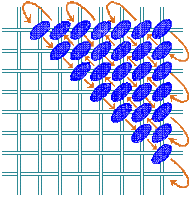 great consolation, the most beautiful work of her life. She could realize, thanks to the benevolence of Louis the XIVth her desire to accomodate and educate poor girls of the nobility, to form them with the marriage and their nearest life in the world. Nothing in the kingdom were then neglected Tell me more than education of the young girls.
great consolation, the most beautiful work of her life. She could realize, thanks to the benevolence of Louis the XIVth her desire to accomodate and educate poor girls of the nobility, to form them with the marriage and their nearest life in the world. Nothing in the kingdom were then neglected Tell me more than education of the young girls.
Saint-Cyr l'école village: A colony of Christians, established near the
place where Cyr, a young martyr under Diocl�tien, is at the origin of an agglomeration which took the name of the holly man.
In 1568 Albert de Gondi, adviser of the Queen Catherine de Médicis acquired the village of Noisy-le-Roi and its surroundings. He decided
to build a castle to the edge of the forest. During the next century, with the visits of the famous members of the royal family, the village and its castle became the anteroom of French monarchy.
In 1686 Louis the XIVth gave at the disposal of Madam de Maintenon the castle in intend to establish lodge of a boarding school for the poor girls of the nobility.
The Royal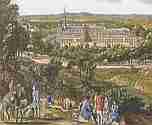 House for the education of the girls was so born. Hundred pupils lived there. A few years later, after Noisy-le-Roi, the school was transferred in Saint-Cyr a small city close to it. The school of Saint-Cyr opened its doors in July 1686. Tell me more than 3100 girls will be raise with the expenses of the State. The boarders were allowed between 7 and 10 years; they left there at 20 years age old with a dowry 3000 pounds. House for the education of the girls was so born. Hundred pupils lived there. A few years later, after Noisy-le-Roi, the school was transferred in Saint-Cyr a small city close to it. The school of Saint-Cyr opened its doors in July 1686. Tell me more than 3100 girls will be raise with the expenses of the State. The boarders were allowed between 7 and 10 years; they left there at 20 years age old with a dowry 3000 pounds.
On this institution Paul Verlaine wrote: "When Maintenon threw on which charmed France the soft shade and the peace of her caps of flax..."
The first representation of Esther, tragedy wrote by Racine at the
request of Madam de Maintenon, took place at Saint-Cyr school in 1689 in the presence of Louis XIVth. The private representations were reserved for a small number of elected officials among others Madam de Sévigné. Here is what Madam de La Fayette writes in her memories: "Mrs. de Maintenon to divert her young girls and the king, ordered a comedy to Racine, the best poet of time, which he drew from his poetry where he was inimitable, to write some, for his misfortune and also of those which have the taste of the theatre, a quite imitable historian..."
Back wrote by Racine at the
request of Madam de Maintenon, took place at Saint-Cyr school in 1689 in the presence of Louis XIVth. The private representations were reserved for a small number of elected officials among others Madam de Sévigné. Here is what Madam de La Fayette writes in her memories: "Mrs. de Maintenon to divert her young girls and the king, ordered a comedy to Racine, the best poet of time, which he drew from his poetry where he was inimitable, to write some, for his misfortune and also of those which have the taste of the theatre, a quite imitable historian..."
Back
|
|
Petit Point from saint Cyr (the basketweave stitch).

It is at the same time complex and simple like is the female psychology. A needlepoint stitch which can perfectly get married with the canvas of which it knows that without that it should not be living at all. A stitch which likes doing up with what it hold back and to intertwine it with its coloured arms.
A small stitch which dances as does the small steps of these ternary "bourrée" and minuet of XVIIth century of fashion in the good company of this time and which inspired Jean Batiste Lully and Jean-Philippe Rameau:
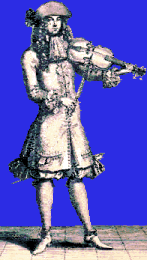
¶ I. a small stitch of skew in front of then
¶ II. two steps aside while swivelling slightly,
¶ III. a small stitch of skew in front of,
¶ I. two steps back while being turned over,
¶ II. a small stitch of skew ahead and
¶ III. two steps back while swivelling,
¶ I. a small stitch of skew in front of then
¶ II. two steps toward the other side and again
¶ III. a small stitch aside then one starts again,
¶ I. two steps toward the other side,
¶..) cover the warps while going down the poles and...
¶...) the wefts while going up the stairs!
A stitch which goes up then go down again and always of a strong and entrainant step.
A stitch of which the visible part enchants you by the admirable things which are represented there and the invisible part seems to be a fortress, so much and so that one wonders how from so many hidden rigours can have been done so much from sublimes imaginations. A stitch of skew which does not deform what it links, making square in its finished what he had found square in his principle. A stitch which although using the softest fibres as the wool or most fragile as silk created a work which resists the wear of time.

The saint-Cyr stitch (basketweave) also kept from its origins the classicism of its century. It is the stitch of Royal tapestry by "Excellence". From this time, the tapestry made by saint-Cyr stitch (basketweave) becames a social movment and invades the boudoirs and the living rooms. One finds it on a tapestry of Madam de Mailly that Louis XVth lacerated of a blow of knife, later, on the trimmings of armchairs realized by Marie Antoinette for Compiegne castle. Carried out at the court or in the middle-class of province, the tapestry stitched by "saint-Cyr" way entered the history. The important ones of this world will continue the tradition by embroidering tapestries with the Petit Point for their furnitures, the duchess of Berry for her castle of Rosny and the Cambronne General to occupy his old days...
Start
| Tell me more & end
|
|
Blessed be the women, they braid and weave celestial roses for a terrestrial life. (Schiller in "If women")
 The Petit Point is their art! Since the Antiquity and in all the classes of the society this art is maintened by the Tell me more artists of them. As of the time of the Pharaons the needlepoint art appeared with the first work using the needle. One embroidered there already the folds of clothing of Pharaons. Excavations in the Crimea, on the peninsula of kertsch, carried at the ligth some tapestries stitched out with threads and flat gold of a smoothness which testify to the quality of the Greek art of the textile ornament. At the Christian era one finds a tapestry embroidered with the needle to the palate of Khosrô-II (590-628), king of Sassanides. This work is known by the inventory of the plundering of this palate by the Byzantine emperor Héraclius. One says that this tapestry was embroidered by the Princess Chirine, "the Clay Princess", a Christian woman of Byzance which got married Khosrô-II and this one who, to thank for this marvellous work build for her a splendid palate, Kasr-e-Chirin. But what other proof of attachment that this Bayeux tapestry stitched in the XIth century by the Queen Mathilde and recalling the Great Britain Conquest's exploits by her King Guillaume of Normandie? The Petit Point is their art! Since the Antiquity and in all the classes of the society this art is maintened by the Tell me more artists of them. As of the time of the Pharaons the needlepoint art appeared with the first work using the needle. One embroidered there already the folds of clothing of Pharaons. Excavations in the Crimea, on the peninsula of kertsch, carried at the ligth some tapestries stitched out with threads and flat gold of a smoothness which testify to the quality of the Greek art of the textile ornament. At the Christian era one finds a tapestry embroidered with the needle to the palate of Khosrô-II (590-628), king of Sassanides. This work is known by the inventory of the plundering of this palate by the Byzantine emperor Héraclius. One says that this tapestry was embroidered by the Princess Chirine, "the Clay Princess", a Christian woman of Byzance which got married Khosrô-II and this one who, to thank for this marvellous work build for her a splendid palate, Kasr-e-Chirin. But what other proof of attachment that this Bayeux tapestry stitched in the XIth century by the Queen Mathilde and recalling the Great Britain Conquest's exploits by her King Guillaume of Normandie?
The saint-Cyr stitch (basketweave), as impregnated of the spirit of the school
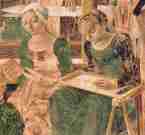 where it was born, is a lesson of modesty.
It is not essential by an extravagant appearance. One would believe to see it having to deal only with one simple half cross stitch (a tent stitch). It is timidly that it is presented at us as must do it the girls of well education. It is only gradually and after long preliminaries that this small stitch reveals not only its hidden face but also its complexity which, let us note it, does not have to be confused here with difficulty. where it was born, is a lesson of modesty.
It is not essential by an extravagant appearance. One would believe to see it having to deal only with one simple half cross stitch (a tent stitch). It is timidly that it is presented at us as must do it the girls of well education. It is only gradually and after long preliminaries that this small stitch reveals not only its hidden face but also its complexity which, let us note it, does not have to be confused here with difficulty.
Madam de Maintenon was to know well all the interest which her girls could learn from the training of this stitch of tapestry. All in this simple stitch meets natural female qualities. It is initially a make up which embellishes what it discovers. It seems complex as first access but by an attention and constant consideration it is nevertheless easily under control. Its structure is solid and resists tirednesses of the fashionable and family life. The patience which is necessary for its realization and its achievement is like the reflection of that necessary to the education of the children. Finally in all its appearances which they are of prestige or domestic its presence cannot never be ignored.
Start page
|
|
|

